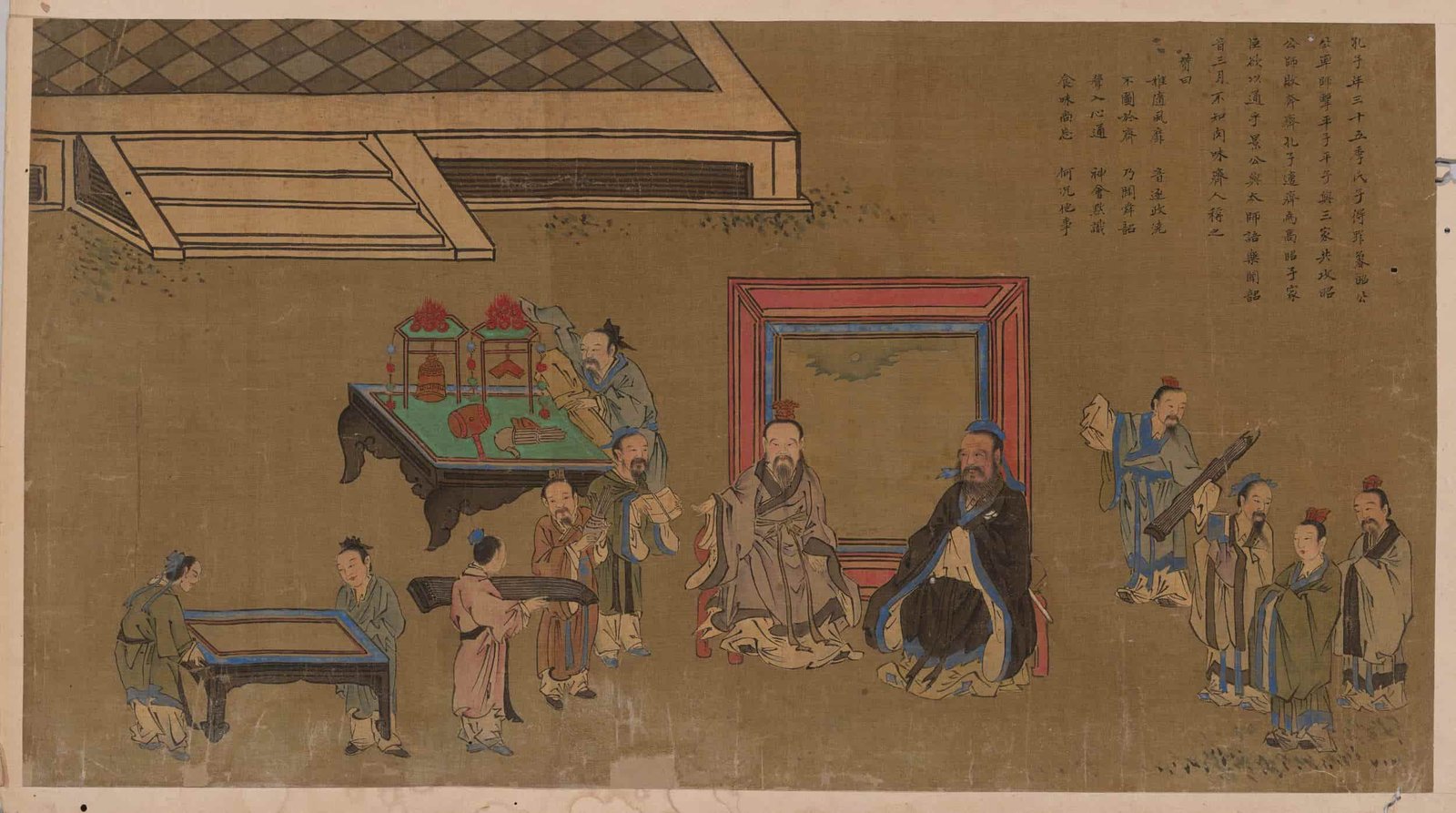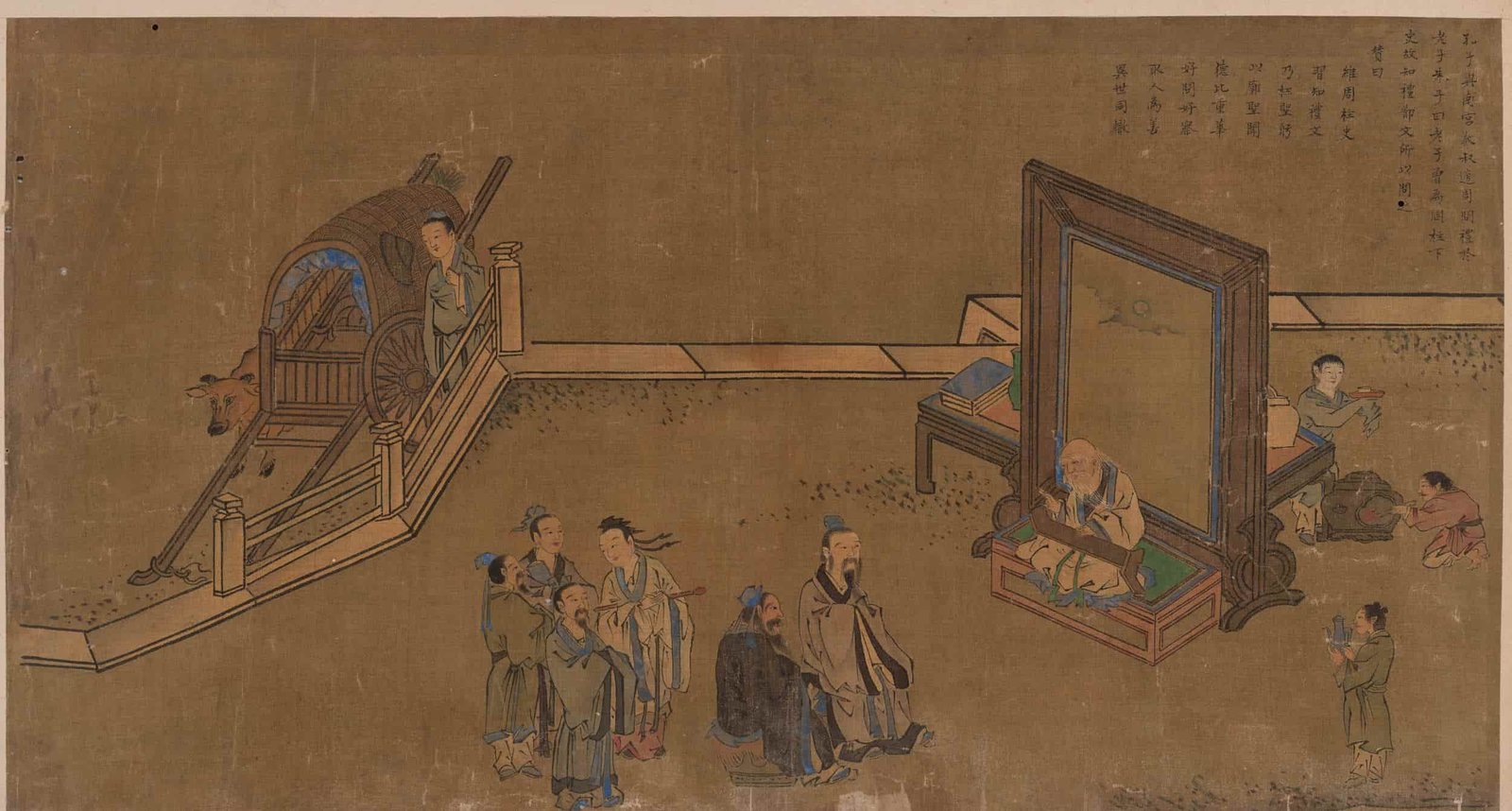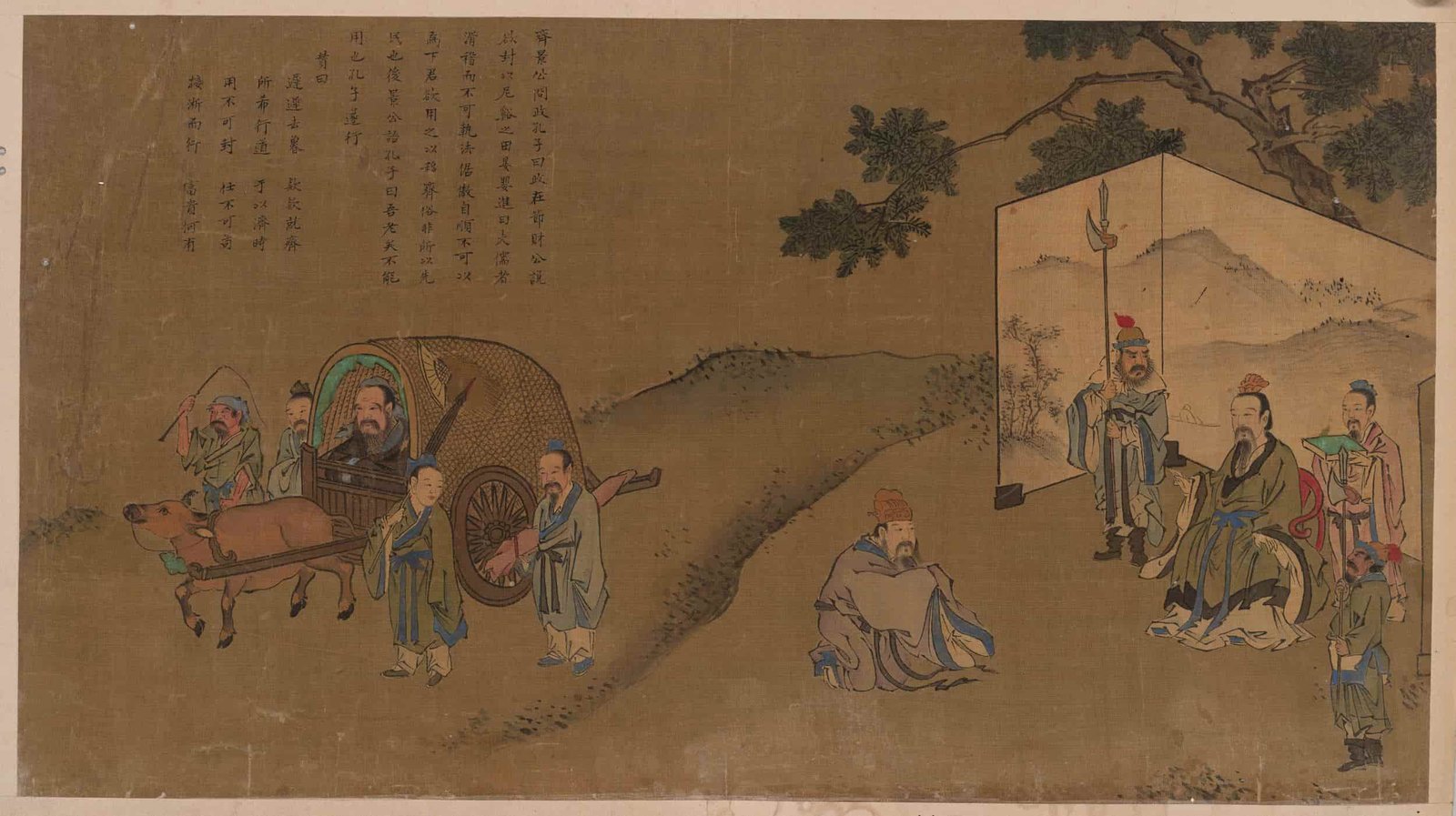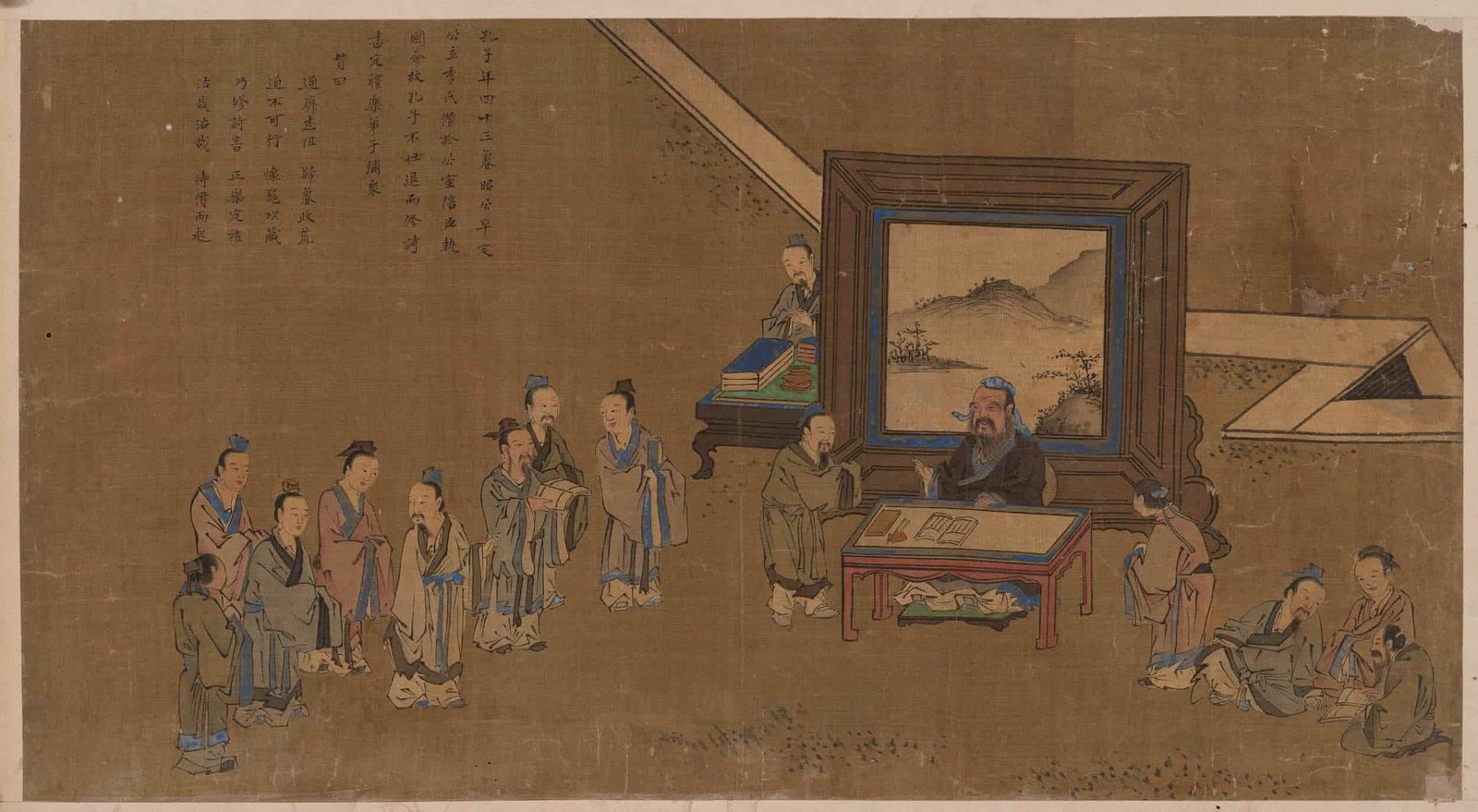Sacred Traces of Confucius: A Ming Dynasty Illustrated Biography”
(孔子圣迹图 / Kǒngzǐ Shèngjì Tú)
Overview
This 36-panel Ming Dynasty silk-scroll album (1465–1505) chronicles the life of Confucius (551–479 ), the “Supreme Sage and Teacher” of Chinese culture. Combining vivid paintings with poetic captions, it blends historical accounts from Records of the Grand Historian and The Analects with mythological motifs, offering both a biography and a spiritual homage. Housed in the Confucius Museum (Qufu, China), it is revered as one of the earliest examples of sequential narrative art in East Asia.
Translation & Cultural Annotations
Key Scenes with Added Context
- Prayer at Mount Ni (尼山致祷)
- Translation: Confucius’ mother, Yan Zhengzai, prays on Mount Ni for a child; Confucius is born with a uniquely shaped head resembling the mountain.
- Cultural Note: His name “Qiu” (丘, “hill”) symbolizes his destined role as a bridge between heaven and humanity. This reflects the Confucian ideal of harmony between nature and human virtue.
- Qilin Bearing the Jade Book (麒麟玉书)
- Translation: A mythical qilin (Chinese unicorn) delivers a jade book predicting Confucius’ future as an “Uncrowned King” (suwang 素王).
- Symbolism: The qilin represents divine endorsement, a motif common in East Asian lore to mark the birth of sages. The prophecy “水精子,继衰周而素王” (“Water’s essence shall revive the declining Zhou as an uncrowned king”) underscores Confucius’ role in preserving Zhou-era virtues.
- Learning Rituals with Play (俎豆礼容)
- Translation: Young Confucius arranges sacrificial vessels (zǔdòu) while playing, foreshadowing his lifelong dedication to ritual propriety (li 礼).
- Philosophical Link: This scene embodies Confucius’ belief that moral education begins in childhood through imitation and reverence, later formalized in his doctrine: “Through rituals, we cultivate benevolence (ren)”.
- Meeting Laozi (问礼老聃)
- Translation: Confucius humbly seeks wisdom from Laozi (founder of Daoism) about Zhou Dynasty rites.
- Historical Context: This encounter, recorded in Records of the Grand Historian, symbolizes the interplay between Confucianism and Daoism. While Confucius focused on social order, Laozi emphasized natural spontaneity (wu wei).
- Exile from Lu (因膰去鲁)
- Translation: Confucius resigns after the Duke of Lu prioritizes sensual pleasures (gifted dancers/horses from Qi) over governance.
- Political Critique: Reflects Confucius’ teaching: “If a ruler’s conduct is correct, governance happens without orders” (Analects 13:6). His departure marks the start of his 14-year exile, seeking a “virtuous ruler”.
Artistic & Historical Significance
- Ming Aesthetics:
- Painted on silk with mineral pigments, the album exemplifies gongbi (工笔) technique—meticulous brushwork for textures (e.g., qilin’s scales, ceremonial robes).
- Scenes like West Hunting Captures the Qilin (西狩获麟) use symbolic colors: red for divinity, azurite for sorrow as Confucius mourns the slain qilin.
- Confucian Propaganda:
- Commissioned during the Ming Confucian revival, it legitimized imperial rule by linking emperors to Confucian virtue. For example, Han Emperor Sacrifices to Confucius (汉高祀鲁) shows Han Gaozu (r. 202–195 BCE) honoring Confucius, reinforcing state-sanctioned worship.
- Global Parallels:
- The sequential narrative predates Western comics by centuries. Compare to the Bayeux Tapestry (11th century), but with philosophical depth over martial glory.
Supplementary Content for Western Audiences
Core Confucian Concepts
- Ren (仁): “Benevolence”—Exemplified in Children’s Games (群婴杂戏), where Confucius teaches regardless of social class.
- Li (礼): “Ritual Propriety”—In Duke Ling Asks About Warfare (灵公问阵), Confucius rejects unjust war, insisting rulers must act according to their titles.
- Golden Rule: “Do not impose on others what you do not desire” (Analects 15:24), echoed in scenes like Survival in Chen (在陈绝粮).
Legacy in Modern Culture
- UNESCO Recognition: Confucius’ educational ideals inspired UNESCO’s Prize for Ethics in Science (2025 shortlist includes AI ethics frameworks based on Analects).
- Pop Culture: The 2024 animated series Confucius: Sage of the Ages adapts scenes like Survival in Chen, highlighting his resilience.
Full Translation of 36 Scenes
(Selected highlights with cultural annotations)
- Jia Valley Summit (夹谷会齐)
- Translation: Duke Ding of Lu and Duke Jing of Qi meet at Jia Valley. Confucius, as Lu’s diplomat, condemns Qi’s “barbaric music,” forcing Qi to cede territory.
- Context: Demonstrates Confucius’ diplomatic genius—using ritual (li) as soft power, a cornerstone of his political philosophy.
- Learning the Wen Wang Melody (学琴师襄)
- Translation: Confucius masters the zither melody Wen Wang Cao (文王操), realizing it embodies King Wen’s virtue.
- Philosophy: Music as moral cultivation—”Harmony between notes mirrors harmony in governance” (Analects 3:23).
- Dream of Pillars (梦奠两楹)
- Translation: On his deathbed, Confucius dreams of funeral rites between pillars, a Zhou royal privilege. He accepts death calmly, singing: “The sacred mountain crumbles; the sage withers.”
- Symbolism: Pillars represent his unfulfilled political ambitions, yet his legacy stands eternal.





评价
目前还没有评价